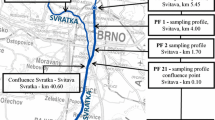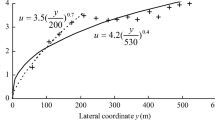Abstract
A field tracer test and two-dimensional numerical modeling were used to analyze the scalars transport in an 8.0-km reach of the Salado River (Santa Fe) where urban and industrial pollutants are released. Rhodamine WT was injected as tracer, and its concentration was recorded in three sections located at 1000, 3000, and 4500 m. SisBaHiA numerical model was used to represent the hydrodynamics and the scalar transport. The transverse and longitudinal dispersion coefficients obtained from fitting the observed concentration curves were in the range of 0.0078–0.037 m2/s and 0.25–1.46 m2/s, respectively. The best fit was achieved with the classical ratios: \({K}_{L}/{u}_{*}H=5.93\) and \({K}_{T}/{u}_{*}H=0.15\). Both measurements and simulation showed the presence of the tracer in the banks at 1000 m from the injection point, but the particle transport model revealed the heterogeneous distribution of the tracer at the section width in the whole study reach. The maximum concentration curves were located near of the banks, which could be due to the fact that the concentration was maximized when the particle cloud reaches these shallower zones. The complex flow pattern caused by bathymetric irregularities and sharps bends largely explains the deformation of the concentration curves. The large spatial variations of the line of maximum velocity caused the particles to evolve with increasing relative displacements to each other. While that in S1 zone, the particles and concentration curves showed typical pattern with relatively concentric concentration isolines towards the middle of the section, the S2 and S3 zones showed a large particles dispersion with long tails, mainly on the left bank.











Similar content being viewed by others
Availability of data and material
The datasets generated during and/or analyzed during the current study are available from the corresponding author on reasonable request.
Code availability
The software used in the present work is publicly available at the website http://www.sisbahia.coppe.ufrj.br/.
References
Baek, K. O. (2018). Flowchart on choosing optimal method of observing transverse dispersion coefficient for solute transport in open channel flow. Sustainability, 10(5), 1332. https://doi.org/10.3390/su10051332
Baek, K.O. and Seo, I.W. (2008). Prediction of transverse dispersion coefficient using vertical profile of secondary flow in meandering channels. Journal of Civil Engineering, KSCE;12(6), 417–26.
Baek, K. O., & Seo, I. W. (2010). Routing procedures for observed dispersion coefficients in two-dimensional river mixing. Advances in Water Resources, 33, 1551–1559. https://doi.org/10.1016/j.advwatres.2010.09.005
Baek, K. O., & Seo, I. W. (2016). On the methods for determining the transverse dispersion coefficient in river mixing. Advances in Water Resources, 90, 1–9. https://doi.org/10.1016/j.advwatres.2016.01.009
Baek, K. O., Seo, I. W., & Jeong, S. J. (2006). Evaluation of dispersion coefficients in meandering channels from transient tracer tests. Journal of Hydraulic Engineering, 132(10), 1021–1032. https://doi.org/10.1061/(ASCE)0733-9429(2006)132:10(1021)
Baek, D. (2020). Routing method for two-dimensional dispersion coefficients in open channel and its application for remotely sensed tracer tests. Doctoral Thesis of Philosophy in Civil and Environmental Engineering Seoul National University.
Behrens, H., Beims, U., Dieter, H., Dietze, G., Eikmann, T., Grummt, T., Hanisch, H., Henseling, H., Käß, W., Kerndorff, H., Leibundgut, C., Müller-Wegener, U., Rönnefahrt, I., Scharenberg, B., Schleyer, R., Schloz, W., & Tilkes, F. (2001). Toxicological and ecotoxicological assessment of water tracers. Hydrogeology Journal, 9, 321–325. https://doi.org/10.1007/s100400100126
Beltaos, S. (1979). Transverse mixing in natural streams. Canadian Journal of Civil Engineering, 6(4), 575–591. https://doi.org/10.1139/l79-070
Beltaos, S. (1980). Transverse mixing tests in natural streams. Journal of the Hydraulics Division, 106(10), 1607–1625. https://doi.org/10.1061/JYCEAJ.0005532
Blanckaert, K. (2002). Secondary currents measured in sharp open-channel bends. Proc. River Flow, Louvain, Belgium (ed. D. Bousmar & Y. Zech), 1, 117–125. Balkema
Chau, K. W. (2000). Transverse mixing coefficient measurements in an open rectangular channel. Advances in Environmental Research, 4, 287–294.
Choi, H. J. (2017). Determination of dispersion coefficients of 2D advection-dispersion model based on transient tracer tests. Thesis (Doctor) - Seoul National University Graduate School.
Diachishin, A. N. (1963). Dye dispersion studies. Journal of the Sanitary Engineering Division, ASCE, 89(SA1), 3386, 29–49.
Emiliani, F. (1980). Ecología de la contaminación de la cuenca inferior del río Salado. Revista de la Asociación de Ciencias Naturales del Litoral, 11, 41–69. ISSN 0325–2809.
Fischer, H.B., List E.J. Koh R.C.Y., Imberger, J. and Brooks, N.H. (1979). Mixing in inland and coastal waters. New York: Academic Press.
Fischer, H. (1968). Methods for predicting dispersion coefficients in natural streams, with applications to lower reaches of the Green and Duwamish Rivers Washington. Geological Survey Professional, Paper 582-A.
Gagneten, A., & Paggi, J. C. (2009). Effects of heavy metal contamination (Cr, Cu, Pb, Cd) and eutrophication on zooplankton in the lower basin of the Salado River (Argentina). Water, Air and Soil Pollution, 198, 317–334.
Gallo, M., Trento, A. and Álvarez, A., Beldoménico and H., Campagnoli, D. (2006). Dissolved and particulate heavy metals in the Salado River (Santa Fe, Argentina). Water, Air and Soil Pollution, 174, 367-384.
Holly, F.R. (1975). Two-dimensional mass dispersion in rivers. Hydrology papers Colorado State University.
Horita, C. and Rosman, P. C. (2006). A Lagrangian model for shallow water bodies contaminant transport. Journal of Coastal Research, SI 39, 1610-1613.
Huai, W., Shi, H., Yang, Z., & Zeng, Y. (2018). Estimating the transverse mixing coefficient in laboratory flumes and natural rivers. Water, Air and Soil Pollution, 229, 252. https://doi.org/10.1007/s11270-018-3893-z
Jirka, G.H. and Weitbrecht V. 2005. Mixing models for water quality management in rivers: continuous and instantaneous pollutant releases. In Czernuszenko, W. and Rowinski, P. (Eds.), Water quality hazards and dispersion of pollutants (1st ed., pp 1–34). Institute of Geophysics, Polish Academy of Sciences, Warsaw, Poland.
Jung, S. H., Seo I. W., Kim, Y. D. and Park, I. (2019). Feasibility of velocity-based method for transverse mixing coefficients in river mixing analysis. Journal of Hydraulic Engineering, 145(11). https://doi.org/10.1061/(ASCE)HY.1943-7900.0001638.
Lane, S. N., Bradbrook, K. F., Richards, K. S., Biron, P. M., & Roy, A. G. (2000). Secondary circulation cells in river channel confluences: Measurement artefacts or coherent flow structures? Hydrological Processes., 14, 2047–2071. https://doi.org/10.1002/1099-1085(20000815/30)14:11/12%3c2047::AID-HYP54%3e3.0.CO;2-4
Lee, M. E. and Seo, I. W. (2013). Spatially variable dispersion coefficients in meandering channels. Journal of Hydraulic Engineering, 139(2). https://doi.org/10.1061/(ASCE)HY.1943-7900.0000669.
Mamuye, T. E. (2021). Overview of water quality modeling. Cogent Engineering, 8(1), 1891711. https://doi.org/10.1080/23311916.2021.1891711
McGowen, J. H., & Garner, L. E. (1970). Physiographic features and stratification types of coarse-grained point bars: modern and ancient examples. Sedimentology, 14, 77–111. https://doi.org/10.1111/j.1365-3091.1970.tb00184.x
Oberg, K., & Mueller, D. (2007). Validation of streamflow measurements made with acoustic Doppler current profilers. Journal of Hydraulic Engineering, 133(12), 1421–1432. https://doi.org/10.1061/(ASCE)0733-9429(2007)133:12(1421)
Park, I., Seo, I.W., Shin, J. and Song, C. G. (2020). Experimental and numerical investigations of spatially-varying dispersion tensors based on vertical velocity profile and depth-averaged flow field. Advances in Water Resources, 142. https://doi.org/10.1016/j.advwatres.2020.103606
Park, I. (2017). A two-dimensional particle dispersion model for prediction of pollutant mixing in open channels. Doctoral Thesis of Philosophy in Civil and Environmental Engineering Seoul National University.
Parsons, D. R., Jackson, P. R., Czuba, J. A., Engel, F. L., Rhoads, B. L., Oberg, K. A., Best, J. L., Mueller, D. S., Johnson, K. K., & Riley, J. D. (2013). Velocity mapping toolbox (VMT): A processing and visualization suite for moving-vessel ADCP measurements. Earth Surface Processes and Landforms, 38, 1244–1260.
Roldao, J.S.F., Pecly, J.O.G. e Trento, A.E. (1996). Determinação de coeficientes de dispersão mediante traçadores fluorescentes na Laguna Setúbal (Argentina). XVII Congreso Latinoamericano de Hidráulica (IAHR), 1, 57–68, Guayaquil, Ecuador.
Rosman, P. (1987). Modeling shallow water bodies via filtering techniques. Ph.D. Thesis, Ralph M. Parsons Laboratory for Water Resources and Hydrodynamics, Civil Engineering Department, Massachusetts Institute of Technology.
Rosman, P. (2015). Referência Técnica do SisBaHiA®, (http://www.sisbahia.coppe.ufrj.br) Accessed Dec 2020
Rutherford, J. C. (1994). River mixing, Wiley, Chichester, U.K. ISBN 0-471-94282-0.
Sayre, W. and Chang, F. (1968). A laboratory investigation of open-channel dispersion processes for dissolved, suspended, and floating dispersants. Geological Survey Professional. Paper 433-E.
Seo, I. W., Baek, K. O., & Jeon, T. M. (2006b). Analysis of transverse mixing in natural streams under slug tests. Journal of Hydraulic Research, 44(3), 350–362. https://doi.org/10.1080/00221686.2006.9521687
Seo, I. W., Lee, M. E., & Baek, K. O. (2008). 2D modeling of heterogeneous dispersion in meandering channels. Journal of Hydraulic Engineering, 134(2), 196–204. https://doi.org/10.1061/(ASCE)0733-9429(2008)134:2(196)
Seo, I. W., Lee, K. W. and Baek, K. O. (2006). Flow structure and turbulence characteristics in meandering channel. [In Korean.] KSCE Journal of Civil and Environmental Engineering Research, 26(5B), 469–479.
Seo, I.W, Choi, H. J., Kim, Y. D. and Han, E. J. (2016). Analysis of two-dimensional mixing in natural streams based on transient tracer tests. Journal of Hydraulic Engineering, 142(8). https://doi.org/10.1061/(ASCE)HY.1943-7900.0001118.
Smart, P. L., & Laidlaw, I. M. S. (1977). An evaluation of some fluorescent dyes for water tracing. Water Resources Research., 13, 1.
Sung, K.H. (2004). Flow characteristics of secondary currents in curved channels. MS Thesis, Seoul National Univ., Korea.
Villalba, S., Pez, M., Palman, L., Alvarez, A. M. y Trento A. (2017). Caracterización hidrosedimentológica del río Salado (Santa Fe) para un escenario de cauce lleno. V Simposio Sobre Métodos Experimentales en Hidráulica. Buenos Aires, Argentina.
Yotsukura, N. and Cobb, E. D. (1972). Transverse diffusion of solutes in natural streams. USGS, Washington, DC.
Funding
This work was supported by the project PI 50120110100326LI and project PIC 50420150100048LI, of the Universidad Nacional del Litoral (UNL), Santa Fe, Argentina.
Author information
Authors and Affiliations
Contributions
Not applicable.
Ethics declarations
Competing interests
The authors declare no competing interests.
Additional information
Publisher's Note
Springer Nature remains neutral with regard to jurisdictional claims in published maps and institutional affiliations.
Rights and permissions
About this article
Cite this article
Palman, L.E., Trento, A.E. & Alvarez, A.M. Scalar Dispersion in the Salado River Through Tracers Test and Two-Dimensional Model. Water Air Soil Pollut 232, 513 (2021). https://doi.org/10.1007/s11270-021-05436-1
Received:
Accepted:
Published:
DOI: https://doi.org/10.1007/s11270-021-05436-1




